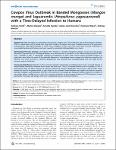Cowpox Virus Outbreak in Banded Mongooses (Mungos mungo) and Jaguarundis (Herpailurus yagouaroundi) with a Time-Delayed Infection to Humans
Kurth, Andreas
Straube, Martin
Kuczka, Annette
Dunsche, Anton Josef
Meyer, Hermann
Nitsche, Andreas
Background: Often described as an extremely rare zoonosis, cowpox virus (CPXV) infections are on the increase in Germany. CPXV is rodent-borne with a broad host range and contains the largest and most complete genome of all poxviruses, including parts with high homology to variola virus (smallpox). So far, most CPXV cases have occurred individually in unvaccinated animals and humans and were caused by genetically distinguishable virus strains. Methodology/Principal Findings: Generalized CPXV infections in banded mongooses (Mungos mungo) and jaguarundis (Herpailurus yagouaroundi) at a Zoological Garden were observed with a prevalence of the affected animal group of 100% and a mortality of 30%. A subsequent serological investigation of other exotic animal species provided evidence of subclinical cases before the onset of the outbreak. Moreover, a time-delayed human cowpox virus infection caused by the identical virus strain occurred in a different geographical area indicating that handling/feeding food rats might be the common source of infection. Conclusions/Significance: Reports on the increased zoonotic transmission of orthopoxviruses have renewed interest in understanding interactions between these viruses and their hosts. The list of animals known to be susceptible to CPXV is still growing. Thus, the likely existence of unknown CPXV hosts and their distribution may present a risk for other exotic animals but also for the general public, as was shown in this outbreak. Animal breeders and suppliers of food rats represent potential multipliers and distributors of CPXV, in the context of increasingly pan-European trading. Taking the cessation of vaccination against smallpox into account, this situation contributes to the increased incidence of CPXV infections in man, particularly in younger age groups, with more complicated courses of clinical infections.
No license information

